

If you still notice a draft beneath your door after you’ve installed weatherstripping, a rolled up towel or “door snake” can further block drafts. Even drapes and blinds can help retain heat in the colder months.
#RETROFIT RADIANT FLOOR HEATING COST WINDOWS#
You can also seal windows for the winter using a plastic sheeting kit you can buy at your local home center or hardware store. Place weatherstripping around loose doors and windows, and caulk obvious holes around window sashes. In both cases, you’ll want to close up the gaps with caulk or insulation.ĭid you know that a one-eighth-inch gap beneath a 36-inch door has the same effect on your home as a 2.4-inch-wide hole in the wall? Sealing gaps around doors and windows is one of the easiest, cheapest, and most effective ways to warm up your older home. The smoke will blow inwards where you have gaps that let outside air in, and it will get sucked toward heat-depleting leaks. On a windy day, simply wave the smoke from the incense near windows, doors, and anywhere else there might be a gap to the outdoors.
#RETROFIT RADIANT FLOOR HEATING COST PROFESSIONAL#
If you find a professional too costly, you can do a basic energy audit yourself by finding leaks with the smoke from a stick of incense. If not, you may wish to hire a professional energy auditor who will go beyond pointing out the obvious sources of heat loss and give you a comprehensive plan for warming up your home. Some utility companies offer energy audits for free, so check with your providers first to see if this is a possibility. An energy audit is a great place to start when you’re seeking to retrofit an older home to make it warmer, because it will show you exactly where most of your warm air is escaping and cold air is entering. Well, in this case, knowledge can actually save you power. You’ve no doubt heard that knowledge is power. There are several smart ways to work with your home’s existing structure to improve its efficiency and make it as warm and comfortable as an old sweater. But living in an older home doesn’t mean you have to put up with drafty doors and cold nights huddled around the fire. About one-third of our nation’s energy consumption comes from the residential sector, and about 70 percent of this can be attributed to homes built before 1983, according to a study by ConSol, a building and energy consulting firm in California.

Older homes certainly have their charm, but they’re not usually the most energy efficient or the easiest to keep warm.


 0 kommentar(er)
0 kommentar(er)
